Pomology
Research with the fruit trees of Okayama, Japan and the World in Mind
Staff
Research Topics
The Okayama region is famous for the high quality of its grape and peach production. One of our aims is to establish new resolution and cultivation methods in order to improve the productivity and quality of grape and peach fruit in Okayama. We are researching to elucidate and develop technology and environmental responses to the climate change that has become a problem in the world. We have been transmitting our research results to the whole of Japan, because we recognize this not merely as a regional issue but as an issue of Japan’s fruit production as a whole. In addition, fruit production in Japan and Okayama is always influenced a great deal by world fruit production, so we promote research and information exchange with overseas research organizations and universities.
Evaluation of the impact of climate change on physiology and fruit quality
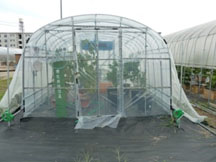 Greenhouse trial for climate change The projected climate change includes an increase in both atmospheric carbon dioxide (CO2) concentration and temperature, both of which will have a significant impact on fruit production and quality in the future. We have been studying the interactive effects of higher temperatures and CO2 on fruit productivity and physiology (photosynthesis, transpiration, water use efficiency, tree growth, fruit quality, dormancy, etc.) to give an overview of the likely impact of climate change and future uncertainties on deciduous and evergreen fruit trees. |
Elucidation of the mechanism of peach fruit disorder, and non-destructive detection method of fruit disorder
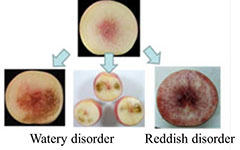 Fruit disorder of peach 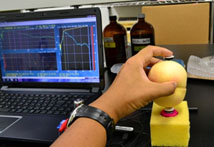 Non-destructive evaluation technique Peach fruit disorder has become a problem in the Okayama region, caused by higher temperatures and excess soil moisture. Our aims are to elucidate the mechanism of this kind fruit disorder, and to establish prevention technologies. In addition, we are developing a non-destructively evaluation method because fruit disorder cannot be identified from appearance. |
Measures and cause of coloring failure of grape skin
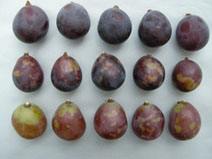 Spot coloring disorder of grape skin
Temperature and precipitation data from different regions are collected for analysis to elucidate the effects of environmental conditions on coloring disorder of grapes. Also, we have been studying and developing counter measures to protect grapes. |
Non-destructive measurement method of biological information
 Water stress indicator sheet stuck on the abaxial side of a leaf changes its color depends on the water status of citrus trees for simple estimation
A simple new estimation method for water status in citrus, grape and peach trees was developed, expecting to improve irrigation during summer and early autumn to control fruit quality. A patch test named “water stress indicator” based on the fact that Cobalt chloride changes its color by hydration reaction was developed. In addition, an estimation method for root mass in the soil using electrostatic capacitance measuring in the trees has been developed. |
Characterization of ultra-late maturing peach varieties
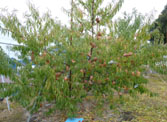 Fruit disorder of peach 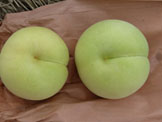 Ultra-late maturing peach varieties Peach varieties have a wide ripening season from July to September in the Okayama region. However, recently ultra-late maturing peach varieties that have a late maturing time in late November were found in the Sojya area, Okayama prefecture. We are researching the optimum harvest time, and ripening method by analyzing the characteristics of mature physiology. |
International research exchange
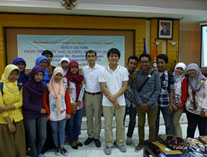 Lecture in University of Trunojoyo We are also exchanging research results with foreign countries for transmission of our research achievements. |
Publication List
- Improvement of inorganic nitrogen condition by summer pruning and fertilization in ‘Muscat of Alexandria’ grape vines under early forcing culture. 2013. Hort.Res. (Japan) 12(2) 147-154.
- ‘Marudori-method’, Mitigation impacts of extreme weather on Satsuma mandarin, 2013. Journal of Irrigation Engineering and Rural Planning. 81(4) 285-288.
- Effects of mulching by bamboo powder on the fruit quality in pot-grown ‘Delaware’ grape. 2013. Rep. Field Science Center, Fac. Agr. Okayama Univ. 35 18-22.
- Influences of bearing position in canopy, time of flowering, and growing period of fruit on the variation of weight and soluble solid content of ‘Benishimizu’ peach fruit. 2012. Hort. Res. (Japan) 11(4) 497-503.